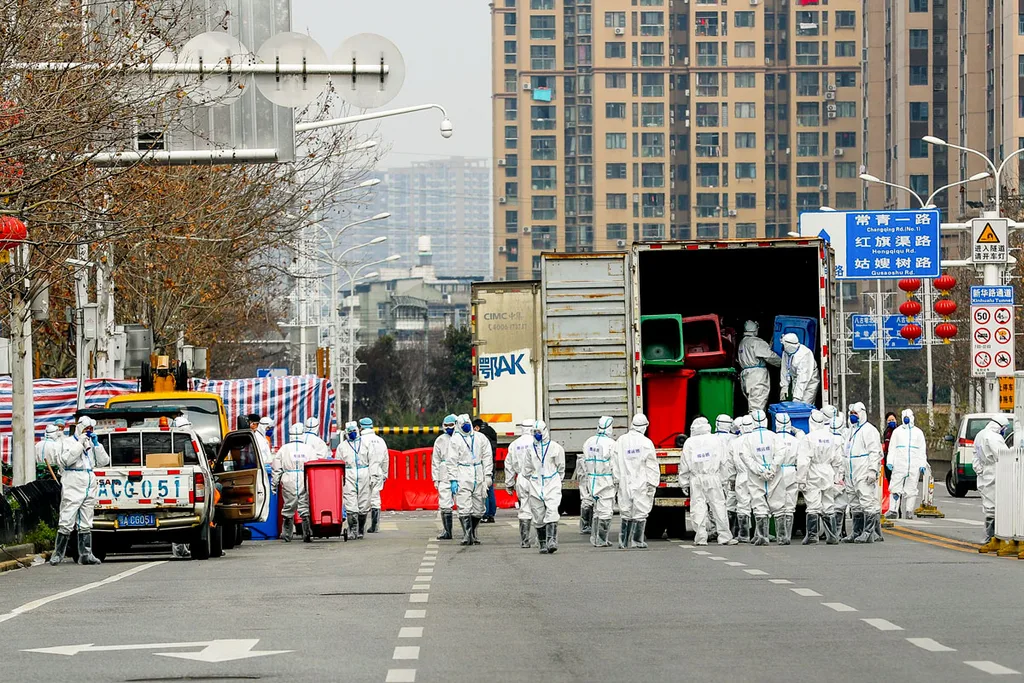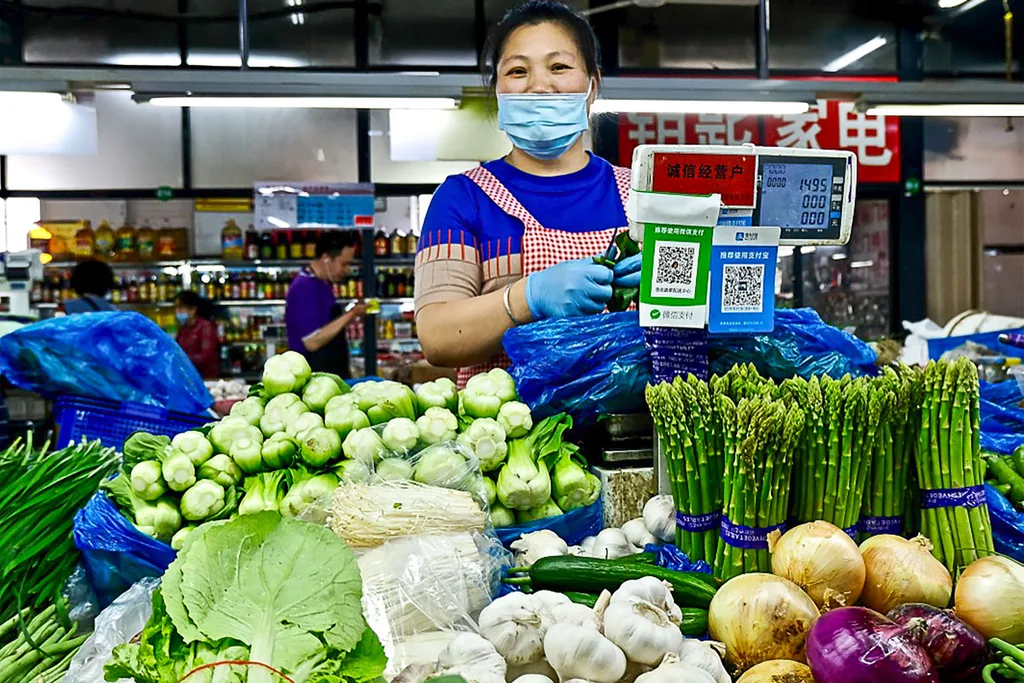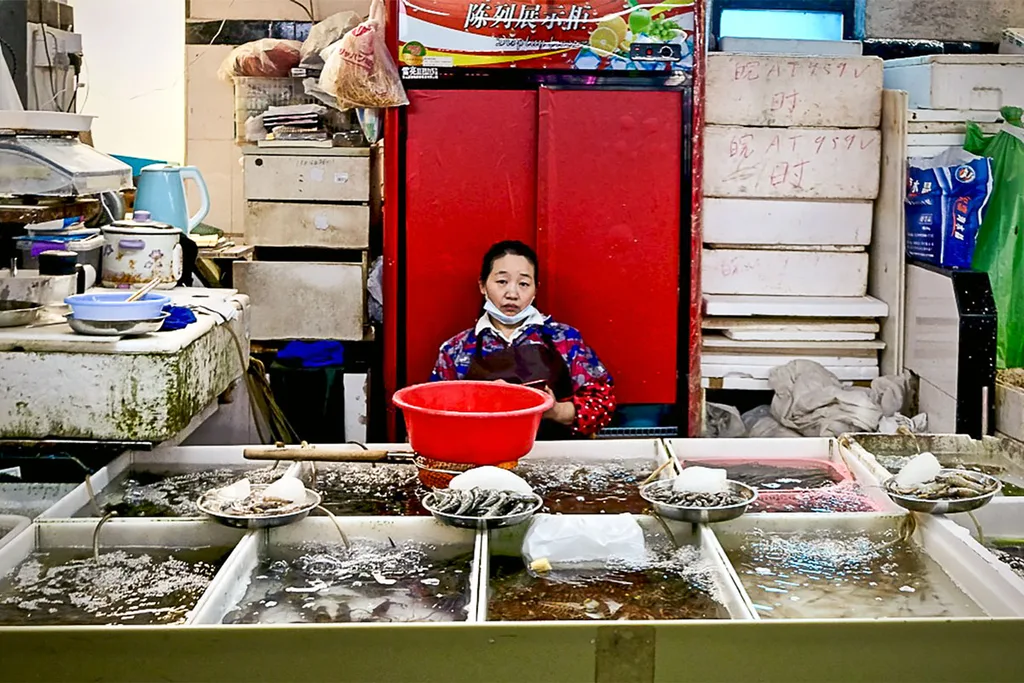A mesh plastic bag pulsates on the slick tiled floor. Inside, a mound of bullfrogs waits, motionless apart from the darting of their eyes and the bulging of their throats. Above them, tiny crabs clamber over one another in a polystyrene tub, while eels flip in a bucket and a river fish is stunned, gutted and descaled on a chopping board stained red with guts. Today, these are the only live animals available for sale in the newly reopened wet markets of Wuhan in China’s central Hubei province – but the city’s shopping scene wasn’t always so tame.
Across town is the now-infamous Huanan Seafood Market, suspected to be the first epicentre of the deadly COVID-19 outbreak. It’s swept across the world and taken hundreds of thousands of lives since Wuhan health officials issued an alert of a new virus on December 31, 2019. While most of the market was indeed dedicated to fish, shoppers could find live porcupines, bats, snakes and more in tucked-away corners, ready to be slaughtered onsite.
As the city of 11 million slowly gets back to life following its official reopening on April 8 – after 76 days in lockdown – old men recline on park benches, taking in the air between puffs of their cigarettes, while masked children race around, finally able to play on the bikes gifted to them for Lunar New Year. Huanan Seafood Market, however, remains firmly closed, surrounded by a 2.5-metre-tall barrier. The only sign that there was once life inside is an intense, gamy smell emanating from within, like dozens of refrigerators were switched off, their contents left to rot. Chances are, this is exactly what happened when the market was hastily shuttered for investigation on January 1.
Wet markets – so called because of their tendency to be damp, with ice thawing on fish trays and floors constantly mopped – are the main source of food distribution in China, despite the rise of supermarkets in the 1990s. Similar to farmers’ markets in the West, they’re made up of independent vendors, all of whom have either grown, raised or personally selected the produce they peddle. National figures are hard to come by, but Shanghai, China’s commercial capital with a population of more than 24 million, is said to have about 1000. They cater to all levels of society, serving as a vital source of social interaction for older folk and a valuable source of nutrition – away from additive-packed instant noodles – for children. As of the end of March, 94 per cent of China’s temporarily closed wet markets have reopened, minus any wild meat components, according to state media.

A team disinfects Huanan Seafood Market in March.
Part of the fabric of everyday life in China, as well as much of Asia, these markets now find themselves under intense scrutiny, with everyone from US infectious disease expert Dr Anthony Fauci to Australia’s Health Minister Greg Hunt and former Beatle Paul McCartney all calling for their closure. The semantics have been somewhat confused, however, as most of China’s wet markets do not sell or slaughter live animals, other than aquatic species. The majority of markets stopped selling exotic animals after the 2003 SARS outbreak, which, according to Chinese scientists, was passed from a bat to a civet cat, which then infected workers at a wet market in the South China province of Guangdong (and went on to kill at least 774 people across 29 countries). Live poultry has also disappeared from several provinces since H7N9 avian flu, found to have a strong link to live bird markets, emerged along China’s east coast in 2013.
Despite its namesake, Wuhan’s Huanan Seafood Market was, in fact, a wildlife market, a type rare before and now banned in China in the wake of the COVID-19 outbreak. Two southern Chinese cities, Shenzhen and Zhuhai, have also since outlawed the sale and consumption of cat and dog meat, a habit increasingly frowned upon by modern, urbane Chinese. But with chickens, ducks and rabbits still available for slaughter in wet markets in more remote areas of China, along with spotty hygiene and inspection practices, disorientating grey areas and lax enforcement of the law, is it enough to stop the next epidemic?
Wang Zaifang has been working in one of Shanghai’s smartest indoor wet markets since it opened 12 years ago. Hailing from a family of farmers in China’s eastern coastal province of Shandong, the 45-year-old sells only the prettiest vegetables from her relatives’ farms, from glossy skinned eggplants to corn cobs encrusted with jewel-like golden kernels. For the rest of her stock, her husband rises at 2am each day to ensure he gets the pick of the harvest at the nearest produce distribution centre, before delivering the bounty to Zaifang’s stall for cleaning and prep.

Wang Zaifang with her farm-fresh vegetables.
“People in Shanghai want everything to look uniform and perfect,” she says, systematically pruning clumps of fresh spinach. “We make sure everything looks clean and fresh.” And, according to Zaifang, clean and fresh is what you get. Her colleagues in the meat section have sold no live animals other than seafood for several years and the market has been disinfected daily since the
coronavirus outbreak. “Things are being monitored very well and the virus was never that serious here, so I’m not worried we’ll be closed down,” she insists, her confidence only slightly muffled by a medical face mask.
A few stalls on, a freckle-faced woman going by Lin Aiyi (Aunty Lin) extols the virtues of wet markets. “Not only is it cheaper, which is important for people on lower incomes, but the products are also better quality because we pick them ourselves,” the 43-year-old explains, pointing to a punnet of loose, puckered dates.
Whether dates or meat, the Chinese are undeniably obsessed with the freshness of their food, with most visiting markets daily. This is partly for social purposes and partly due to a propensity for dinky kitchens with a lack of refrigeration space, but also because of a belief that fresh is best. Hence the penchant for “warm meat”, bought live and slaughtered to order.

A vendor selling prawns in Shanghai.
China’s taste for wildlife is less straightforward, although the eating of exotic animals dates back thousands of years to the Yellow Emperor’s belief that eating part of an animal will boost the corresponding human part. The trade today is worth about $112 billion.
The whole country was forced to become more adventurous with their meat choices during the famine of the Great Leap Forward in the late 1950s, but today it’s a custom largely confined to the country’s southeast, where the saying goes, they’ll eat anything with four legs, other than a table. The consumption of weird and wonderful meat is indeed rare outside southeast China. Even there, it can usually be put down to one of two pursuits: status or health, with animals like the shy, scaly pangolin – the most trafficked species in the world – said to cure everything from rheumatism to erectile dysfunction.
China is not alone in its attraction to wilder meats. Seen as a healthier and less-cruel alternative to farmed meat, venison and wild boar are increasingly popular in Europe. Australians still chow down on crocodile and kangaroo, despite the latter having been shunned by Russia, its biggest importer, in 2014 after it was found to contain unacceptable levels of E. coli. China is also not
alone in being the birthplace of an animal-to-human epidemic – MERS originated from camels in Saudi Arabia, Ebola from bats in Africa, and Nipah from pigs in Malaysia.
While it’s arguably healthier for humans to consume fresh meat with no added preservatives, problems can arise when animals of different species are kept in poor conditions and close proximity, especially when their immune systems are weakened by stress. This is particularly likely when wild, as opposed to farmed, animals are taken to market. Viruses can easily jump from animal to animal, mutating as they move between species and potentially being passed on to their human handlers.
But focusing only on the markets is short-sighted and dangerous, according to Dr Petr Matous, a senior lecturer at the University of Sydney and an expert in environmental interactions in Asia. He points out it’s still not clear where the new coronavirus originated, as the first known COVID-19 patient had no contact with the Wuhan market (according to analysis of the first 41 COVID-19 patients, 27 of them had direct exposure to the market, but not patient zero*), and says the call for a blanket ban on wet markets is “simply nonsense”. While he acknowledges there is room for improvement in both animal welfare and hygiene at the markets, he believes food production and infrastructure standards must be overhauled. “It’s about how we produce food, how we use land and our methods of urbanisation,” he says, adding that crowded and substandard living conditions in city centres also help these viruses spread.

Shopping for meat in Hong Kong.
China has previously implemented several laws banning the sale and consumption of certain wildlife, but even experts remain foggy on the exact rules. Both the old and new bans only apply to certain species and for certain uses, with intentions easily obscured and loopholes expertly exploited. Does an “exotic species” count as wildlife if it’s farmed, for example? Is the bat in that cage being bred for consumption or medical purposes? Experts, including the WWF, warn that trying to remedy the situation with more hastily and crudely implemented laws could push the trade underground, leading to even more risky practices.
Indeed, since the ban on the sale of live birds in Guangdong markets was introduced in 2015, literal backstreet vendors have emerged selling live poultry from vans in tucked-away alleys, to avoid the eyes of the authorities. Exotic species, currently banned for consumption, can also still be found both online and in shady restaurants and markets if you know where to look and who to talk to.
Professor Clive Phillips, from the Beijing-based Sino-Australian Animal Welfare Centre, however, isn’t buying that theory, and says the Chinese would largely step in line if a ban on all live animals in markets was introduced. “The Chinese generally do what they’re told,” he says. “I imagine a ban [on live animals in markets] would be similar to drug taking in China. It still exists, but it’s not very common because it’s illegal.”
While the WHO has called for stricter hygiene standards and proper enforcement of China’s current wildlife regulations, animal rights group PETA has joined the call for a complete ban on live animals in markets. “We notice many wet markets in Asia are still selling live fish, poultry, frogs and rabbits,” PETA Asia press officer Keith Guo told marie claire. “In simple words, tofu never caused a pandemic.”

The markets are popular for seafood.
Rachel Gouk, who writes the popular Nomfluence food blog in Shanghai, puts much of the Western squeamishness surrounding wet markets down to cultural differences. While the Malaysian grew up touring the “seriously dirty, grimy and dark” laneways of Kuala Lumpur’s fresh produce markets, she still gets “creeped out” when seeing live turtles for sale in China. “It’s basically because I didn’t grow up eating turtles, but you could say the same thing about venison and veal,” the 31-year-old admits. “How do you determine what is no-go and what’s OK?”
Across the country in the southwest province of Sichuan, Chengdu Food Tours co-owner Anita Lai is looking forward to introducing more visitors to the city’s bustling wet markets. Packed with ruby-red meats hanging from hooks, and seasonal fruits and vegies, her favourite outdoor shopping spot also sells home-cooked local delicacies, such as chilli-fried crawfish and salted pickles. “I hope wet markets will never be fully closed because it would be a big loss to our culture,” says the sparky 27-year-old entrepreneur. “Wet markets are a reflection of lifestyle here: chill, laid-back, slow paced, sometimes noisy, but happy.”
The way forward, according to Dr Duan Biggs from the Environmental Futures Research Institute at the Griffith School of Environment and Science, would be to implement a framework of international bans and guidelines that take into account the socioeconomic considerations of those involved in the animal trade. “That’s the longstanding failure of governments around the world. I fear, with all these un-nuanced calls for bans … we’re going to run into the same problem. That won’t help prevent the next pandemic,” he says.
Back at the Shanghai wet market, egg vendor Gao Taitai confides there are rumours her workplace will soon be transformed into a supermarket – mimicking Wuhan’s plans to “upgrade” its wet markets at a cost of $43 million. “The government has to be seen to be doing something, but this place is a huge part of life here,” she says. “I really hope that it doesn’t happen. Supermarkets aren’t necessarily cleaner or better.”
This article originally appeared in the July 2020 issue of marie claire.










